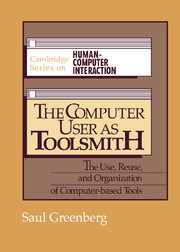Book contents
- Frontmatter
- Contents
- List of figures
- List of tables
- Foreword
- Acknowledgments and dedication
- 1 Introduction
- 2 Studying UNIX
- 3 Using commands in UNIX
- 4 Techniques for reusing activities
- 5 Recurrent systems
- 6 Reuse opportunities in UNIX csh – potential and actual
- 7 Principles, corroboration, and justification
- 8 Organizing activities through workspaces
- 9 A workspace system: description and issues
- 10 Conclusion
- Appendix A A sample trace
- Appendix B Summary statistics for each subject
- References
- Author index
- Subject index
4 - Techniques for reusing activities
Published online by Cambridge University Press: 26 May 2010
- Frontmatter
- Contents
- List of figures
- List of tables
- Foreword
- Acknowledgments and dedication
- 1 Introduction
- 2 Studying UNIX
- 3 Using commands in UNIX
- 4 Techniques for reusing activities
- 5 Recurrent systems
- 6 Reuse opportunities in UNIX csh – potential and actual
- 7 Principles, corroboration, and justification
- 8 Organizing activities through workspaces
- 9 A workspace system: description and issues
- 10 Conclusion
- Appendix A A sample trace
- Appendix B Summary statistics for each subject
- References
- Author index
- Subject index
Summary
Those who ignore history are destined to retype it
— Ben ShneidermanIt is evident that users often repeat activities they have previously submitted to the computer. These activities include not only the commands they choose from the many available in command-driven systems (Chapter 3), but also the complete command line entry. Similarly, people repeat the ways they traverse paths within menu hierarchies, select icons within graphical interfaces, and choose documents within hypertext systems. Often, recalling the original activity is difficult or tedious. For example, problem-solving processes must be recreated for complex activities; command syntax or search paths in hierarchies must be remembered; input lines retyped; icons found; and so on. Given these difficulties, potential exists for a well-designed “reuse facility” to reduce the problems of activity reformulation.
But most system interfaces offer little support for reviewing and reusing previous activities. Typically they must be completely retyped, or perhaps reselected through menu navigation. Those systems that do provide assistance offer ad hoc “history” mechanisms that employ a variety of recall strategies, most based on the simple premise that the last n recent user inputs are a reasonable working set of candidates for reselection. But is this premise correct? Might other strategies work better? Indeed, is the dialog sufficiently repetitive to warrant some type of activity reuse facility in the first place? As existing reuse facilities were designed by intuition rather than from empirical knowledge of user interactions, it is difficult to judge how effective they really are or what scope there is for improvement.
- Type
- Chapter
- Information
- The Computer User as ToolsmithThe Use, Reuse and Organization of Computer-Based Tools, pp. 40 - 64Publisher: Cambridge University PressPrint publication year: 1993

